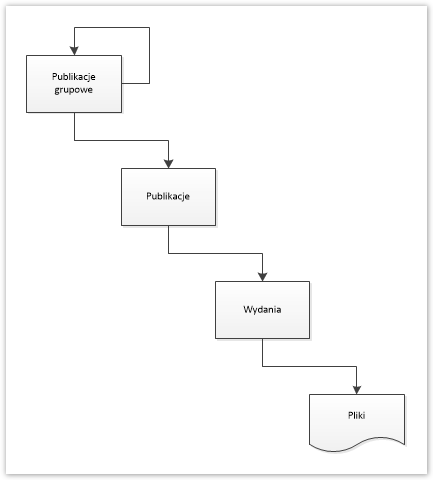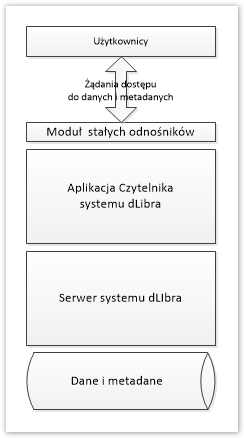Introduction
One very important aspect of making digital objects available online is the ability to creat permanent links to those objects. Such links may be useful, for example, in a scientific work, as an element of a bibliography, or for referring to digital objects in external services, such as library catalogs, bibliographic bases, or even Wikipedia. This section is about the way in which links to digital objects are created in the dLibra system; it is also explained which of them should be used to ensure the maximum durability of the references.
The Data Model of the dLibra System
In the image below, the basic data model in the dLibra system is shown. The model includes:
- group publications – elements which group other group publications and standard publications; group publications can represent, for example, a whole journal or its particular annual or monthly set;
- publications – elements which represent a single digital object in the system; that object may have many versions (editions); it can be, for example, a book or a single number of a journal;
- editions – the versions of a publication; they may correspond to the actual subsequent editions of a book, but they can also be created, for example, when another digital form of the same physical object is made available; many editions of the same publication can exist simultaneously in the system, but in practice only the most recent edition is usually shown to end users; and
- files – the files comprising particular editions of a publication; they contain the data/information which is downloaded by the user using the digital library.
Fig. 1. The basic data model in the dLibra system is shown.
In the table below, examples of particular elements of the data model are shown, together with links
| Object type | Object name/title | The data necessary for an unequivocal identification in the dLibra system | The link used in the website interface. | The permalink. |
|---|---|---|---|---|
| Group publication | Studies in Physical Culture and Tourism | Publication ID: 4081 | http://www.wbc.poznan.pl/dlibra/publication/4081 | http://www.wbc.poznan.pl/publication/4081 |
| Group publication | Studies in Physical Culture and Tourism 2012 | Publication ID: 263176 | http://www.wbc.poznan.pl/dlibra/publication/263176 | http://www.wbc.poznan.pl/publication/263176 |
| Group publication | Studies in Physical Culture and Tourism 2012 Vol.19 No.3 | Publication ID: 290787 | http://www.wbc.poznan.pl/dlibra/publication/290787 | http://www.wbc.poznan.pl/publication/290787 |
| Group publication | Part II - Biology and exercise physiology | Publication ID: 291297 | http://www.wbc.poznan.pl/dlibra/publication/291297 | http://www.wbc.poznan.pl/publication/291297 |
| Publication | Insulin sensitivity and blood lipid profile in women recreationally practicing horseback riding | Publication ID: 291316 | http://www.wbc.poznan.pl/dlibra/publication/291316 | Description: http://www.wbc.poznan.pl/publication/291316 Content (the main file): http://www.wbc.poznan.pl/publication/291316/content |
| Edition | Insulin sensitivity and blood lipid profile in women recreationally practicing horseback riding | Edition ID: 239649 | Description: http://www.wbc.poznan.pl/dlibra/publication/291316/239649 Content (the main file): http://www.wbc.poznan.pl/Content/239649/ | None – using the permalink to the publication is recommended. |
| File | 7_Studies_2012_3_135.pdf | Edition ID: 239649 Full file name: 7_Studies _2012_3_135.pdf | http://www.wbc.poznan.pl/Content/239649/7_Studies_2012_3_135.pdf | None – using the permalink to the publication is recommended. |
Tabela 1. Przykłady poszczególnych elementów modelu danych w systemie dLibra na przykładzie czasopisma dostępnego w Wielkopolskiej Bibliotece Cyfrowej.
Krótkiego komentarza wymaga jeszcze widoczne w Tabeli 1 rozróżnienie pomiędzy plikiem, a plikiem głównym publikacji. Obiekty cyfrowe mogą składać się z jednego lub więcej plików i w tym drugim przypadku niezbędne jest określenie, od którego pliku czytelnik powinien zacząć przeglądanie obiektu. Dla stron HTML przyjęło się, że plik taki nazywany jest index.html, jednak ze względu na to że w systemie dLibra składować można różne rodzaje obiektów, plik główny (plik początkowy) wskazywany jest przez redaktora biblioteki cyfrowej na etapie umieszczania obiektu w bibliotece. Rozróżnienie to dobrze ilustruje następujący przykład:
- http://www.wbc.poznan.pl/Content/8711/ - Link do treści wydania o identyfikatorze 8711 w Wielkopolskiej Bibliotece Cyfrowej, spowoduje przekierowanie do pliku głównego publikacji.
- http://www.wbc.poznan.pl/Content/8711/index.html - Link do pliku głównego treści wydania o identyfkatorze 8711 w Wielkopolskiej Bibliotece Cyfrowej, uzyskany w efekcie przekierowania z adresu http://www.wbc.poznan.pl/Content/8711/.
- http://www.wbc.poznan.pl/Content/8711/tom1-014.jpg - Link do jednego z plików składowych treści wydania o identyfkatorze 8711 w Wielkopolskiej Bibliotece Cyfrowej, uzyskany w efekcie przeglądania publikacji.
Rodzaje odnośników i sposób przetwarzania żądań czytelników
W Tabeli 1 przedstawiono dwa rodzaje odnośników do poszczególnych elementów modelu danych w systemie dLibra. Rozróżnienie to wynika z przyjętego sposobu przetwarzania żądań czytelników zilustrowanego na Rysunku 2. Kluczowe jest tutaj rozróżnienie pomiędzy Aplikacją Czytelnika, a modułem stałych odnośników. Moduł ten ma za zadanie uniezależnić część odnośników funkcjonujących w systemie dLibra od zmian technicznych zachodzących w Aplikacji Czytelnika, związanych z jej rozwojem, udostępnianiem kolejnych wersji i wprowadzanymi modernizacjami technologicznymi. Ostatnia kolumna w Tabeli 1 przedstawia przykłady takich stałych odnośników. Zadaniem modułu obsługującego te odnośniki jest zapewnienie, aby funkcjonowały one w taki sam sposób niezależnie od zmian wprowadzanych w kolejnych wersjach Aplikacji Czytelnika. Przedostatnia kolumna w Tabeli 1 przedstawia odnośniki funkcjonujące niezmienne w systemie dLibra od wersji 0.4 wydanej w 2004 roku do chwili obecnej, jednak teoretycznie w przyszłości ze względów technicznych mogą one ulec zmianie, dlatego też przy tworzeniu referencji do obiektów zaleca się stosowanie stałych odnośników zaprezentowanych w ostatniej kolumnie.
Rys. 2. Uproszczony schemat architektury systemu dLibra.
Stałe odnośniki a sytuacje wyjątkowe
W pewnych specyficznych przypadkach zapewnienie trwałych odnośników nie jest możliwe wyłącznie w oparciu o system biblioteki cyfrowej. Patrząc na przykładowy stały odnośnik (np.: http://www.wbc.poznan.pl/publication/290787) można stwierdzić, że posiada on dwa elementy które mogą ulec zmianie. Są to
- Adres domenowy (w przykładzie: www.wbc.poznan.pl) - może ulec zmianie, na przykład gdy:
- właściciel domeny zapomni przedłużyć jej ważności i po wygaśnięciu własności domeny wykupi ją ktoś inny i zacznie stosować do innych celów;
- instytucja macierzysta zmieni swoją nazwę i domenę (np. z Akademii na Uniwersytet);
- biblioteka cyfrowa zmieni swój charakter (np. z instytucjonalnej na regionalną) i domenę.
- Identyfikator systemowy publikacji w ramach biblioteki cyfrowej (w przykładzie: 290787) - może ulec zmianie na przykład w efekcie awarii sprzętu powodującej utratę danych. Gdy administrator nie posiadał kopii zapasowej biblioteki cyfrowej, ale posiada kopie poszczególnych obiektów i ich metadanych to jedynym rozwiązaniem jest zbudowanie biblioteki cyfrowej od nowa. W takiej sytuacji mimo, że adres domenowy biblioteki cyfrowej i oprogramowanie nie ulegną zmianie, to systemowe identyfikatory poszczególnych obiektów najprawdopodobniej zmienią się, gdyż są one nadawana zależnie od kolejności wprowadzania obiektów.
Aby zapobiec tego typu wyjątkowym problemom stosuje się systemy identyfikatorów zewnętrzne w stosunku do biblioteki cyfrowej. Najpopularniejszym tego typu komercyjnym systemem są identyfikatory DOI, a jedną z bezpłatnych alternatyw jest system Handle. W polskich bibliotekach cyfrowych przyjęły się powszechnie oparte o specyfikację OAI Id identyfikatory obsługiwane przez Federację Bibliotek Cyfrowych. Tego typu zewnętrzne identyfikatory wprowadzane są jako element metadanych opisowych obiektu, dzięki czemu stają się niezależne od identyfikatorów systemowych. Uniezależnienie od adresu domenowego uzyskuje się poprzez globalne usługi lokalizujące (tzw. resolvery).
Dla przykładu - do artykułu "The use of SEM morphoscopy in researching the litho-pedogenetic environments evolution of Late Pleistocene and Holocene" dostępnego w Repozytorium Cyfrowym Instytutów Naukowych PAN można w sposób trwały odwołać się na następujące sposoby:
- http://rcin.org.pl/igipz/publication/13932 - Odnośnik na poziomie biblioteki cyfrowej
- http://fbc.pionier.net.pl/id/oai:rcin.org.pl:2289 - Odnośnik wykorzystujący identyfikator OAI, realizowany w oparciu o usługę Federacji Bibliotek Cyfrowych
- http://fbc.pionier.net.pl/id/10.7163/GPol.2011.S1.3 - Odnośnik wykorzystujący identyfikator DOI, realizowany w oparciu o usługę Federacji Bibliotek Cyfrowych
- http://dx.doi.org/10.7163/GPol.2011.S1.3 - Odnośnik wykorzystujący identyfikator DOI, realizowany w oparciu o usługę dx.doi.org.
Summary
By way of a summary, the table below contains the advantages and disadvantages of particular kinds of links to objects available in the dLibra system.
| Object type | The link used in | The effect of calling the object | Comment | Recommended? |
|---|---|---|---|---|
Group publication | http://www.wbc.poznan.pl/publication/4081 | Displaying the structure of a group publication |
| |
| http://www.wbc.poznan.pl/dlibra/publication/4081 | Displaying the structure of a group publication |
| ||
| Publication | http://www.wbc.poznan.pl/dlibra/publication/291316 | Displaying the metadata of the only available release of the given publication or a list of links to the releases of that publication when there is more than one release of that publication (in practice, that is a very rare occurrence). |
| |
| http://www.wbc.poznan.pl/publication/291316 | Displaying the metadata of the only available release of the given publication or a list of links to the releases of that publication when there is more than one release of that publication (in practice, that is a very rare occurrence). |
| ||
| http://www.wbc.poznan.pl/dlibra/publication/291316/edition/239649/content | Displaying the content of the only available release of the given publication or a list of links to the releases of that publication when there is more than one release of that publication (in practice, that is a very rare occurrence). |
| ||
| Release | http://www.wbc.poznan.pl/dlibra/publication/291316/edition/239649 | Displaying the metadata of the given publication release. |
| |
| File | http://www.wbc.poznan.pl/Content/239649/ | Displaying the main file of the given publication release |
| |
| http://www.wbc.poznan.pl/Content/239649/7_Studies_2012_3_135.pdf | Displaying a particular PDF file of the given publication release |
| ||
| http://www.wbc.poznan.pl/Content/239649/7_Studies_2012_3_135.pdf#page=3 | Displaying a particular fragment (page 3) of a particular PDF file of the given release of the publication. |
|
Table 2 The advantages and disadvantages of particular kinds of links to objects in the dLibra system.

